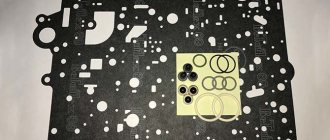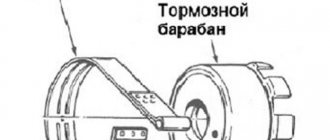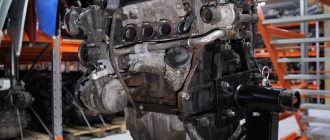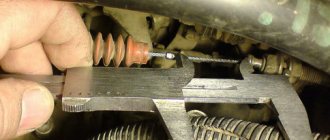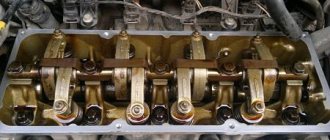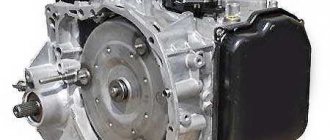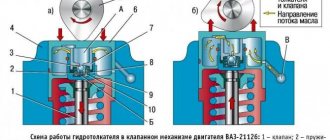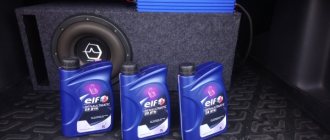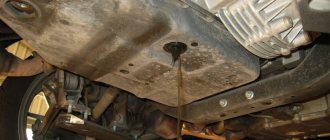When operating modern vehicles equipped with automatic transmissions, the transmission oil, as well as working units and parts of the automatic transmission, gradually become contaminated. Harmful sediments in the form of metal dust, shavings, fragments, combustion products and breakdown of friction clutches accumulate on working surfaces, filter screens, as well as in the cavities and channels of the hydraulic system. Flushing the automatic transmission is a necessary procedure to restore the stability of the transmission.
Why do you need to flush the automatic transmission?
During operation of the automatic transmission, the amount of mud deposits increases, which causes failure of both individual parts and the mechanism as a whole. Some car enthusiasts believe that they can get by with simply replacing the transmission oil and oil filter. However, as practice shows, in order to restore the stable functioning of an automatic transmission, simply replacing the lubricant is not always enough. To independently adjust the operation of the automatic transmission, washing the automatic transmission yourself is the best solution.
What is the essence of such an action as automatic transmission flushing? The answer is simple: an accessible way to clean the cavities of the gearbox from accumulated dirt is determined. The most commonly used method is flushing the machine’s channel system using lubricating fluid flows. Sometimes a special flushing agent or automatic transmission flushing fluid (Liqui Moly) is added to the transmission oil.
If this does not help, the gearbox is completely disassembled. After which, each part is cleaned manually using gasoline and compressed air.
Each of the described methods is successfully used in practice. The results of proper cleaning of the automatic transmission are noticeable in the following manifestations:
- The likelihood of automatic transmission breakdowns is reduced.
- The service life of the entire mechanism increases.
- The operation of the automatic transmission is corrected.
In order for flushing an automatic transmission to achieve maximum efficiency, it is necessary to perform each operation competently and accurately.
Hydraulic unit care
Hydraulic unit, inside view
With prolonged use of the vehicle, the transmission fluid gradually becomes contaminated. The result of this is the failure of the components of the gearbox.
When servicing the automatic transmission for the first time, it may be necessary to replace the solenoids and clean the automatic transmission valve body. This allows you to extend the service life of the transmission. The cost of repairing the hydraulic unit depends on the nature of the existing breakdown. Malfunctions of this device mainly occur as a result of overheating of the transmission and the use of dirty oil. Overheating of the gearbox leads to deformation of its parts, the valve body, the repair of which may involve replacing springs and valves.
What is dangerous about the presence of sediment in the form of metal shavings and combustion products in oil? The presence of these substances helps reduce the service life of the gearbox. In particular, filters and hydraulic system channels become clogged. The correct option in this situation is to flush the automatic transmission. Carrying out this procedure helps restore the stability of the transmission system.
In what other cases is flushing required? We list the main reasons for the need to clean the automatic transmission:
- gears are difficult to shift;
- the appearance of shocks during acceleration;
- instability of the functioning of the checkpoint.
If this procedure does not help solve the problem, it is advisable to order automatic transmission diagnostics, the results of which require disassembling the box and replacing worn parts.
Thus, the oil constantly circulates through the transmission channels; over time, wear products form in it, which clog the valve body channels. Because of this, the solenoids fail. As a result, the box begins to push when switching. A procedure such as flushing the gearbox can solve the problem.
How often do you need to flush the automatic transmission?
During active use of the gearbox, it is recommended to flush the automatic transmission, in particular, to clean the valve body channels, simultaneously with a complete change of transmission oil (automatic transmission oil change with flushing). The service life of a vehicle transmission directly depends on the frequency of these activities. Flushing the automatic transmission when changing the oil means that the frequency of work is 30 - 70 thousand km of the distance traveled. The interval between automatic transmission maintenance activities is set depending on the operating conditions of the vehicle.
How to flush the automatic transmission valve body and how to do it
First of all, before you start washing the hydraulic plate of the machine, you need to prepare the necessary materials and tools. As a rule, you need to have a new automatic transmission oil filter, you will also need oil pan gaskets, an O-ring for the filler plug, and an automatic transmission valve body gasket.
At the same time, you should prepare keys for removing the pan, containers for draining old oil, and clean rags. You also need to purchase transmission oil (8-10 liters), carburetor cleaning fluid (3-5 liters), a “Galosh” type cleaner, brushes (the bristles should be hard), prepare a container of water, stock up on rags (preferably lint-free ).
The place where the work will be performed must be clean, free from dust, drafts, etc. It is important to prevent dust, debris, particles, lint, etc. from getting on automatic transmission parts. Before you start cleaning the automatic transmission valve body, it is recommended to separately study the issue of removing the valve plate (valve block) on a specific automatic transmission model.
Having figured out how to remove the valve body from the automatic transmission on one or another box, you can get to work. In general terms, you will need to unscrew the drain plug with a wrench, drain the old oil, then tighten the plug. After this, you need to remove the automatic transmission pan and disconnect the electrical connector plug. To do this, you need to turn the plastic lock, after which you can disconnect the connector itself.
Then the connector adapter is removed, after which you can begin removing the block. First, you need to very carefully unscrew the bolts that secure the hydraulic unit. It should be remembered that the block is divided into two parts (front and rear), and when unscrewing and tightening the bolts, you need to follow the order (it is better to remember the position of the bolts).
- Let us also add that disassembling the valve body is a complex operation. The block consists of 4 parts (plates) connected to each other by plates. Each such slab has paths that become clogged with deposits and wear products. However, it is impossible to wash them without disassembling the hydraulic unit.
First, the “large” (front) part of the block is unscrewed, then the remaining bolts are unscrewed, then the “small” (rear) part of the valve body is removed. Next, you should slowly lift the intermediate plate of the valve body (the remaining plates are removed in the same way).
In other words, we remove the first plate, and after unscrewing the last bolt, it is advisable to remove the plate along with a special spacer plate. If this is not done, certain elements may fall out and assembly problems may arise.
It turns out that when the time comes to remove the rods, the plates need to be unscrewed so that the springs between them are not accidentally lost. After removing the hydraulic unit, you can start washing it.
Cleaning and washing the valve body of the automatic transmission
After disassembly, you need to remove dirt from the parts using a hard-bristled brush. Then the parts are washed with an aerosol for cleaning carburetors. It is also important to thoroughly clean the solenoids with carbicleaner. After this, you can wash the parts again with gasoline.
- After washing the automatic transmission valves, you need to wipe the parts with a clean cloth and dry (blow with compressed air is optimal).
- In the same way, the plates, spool mechanisms of the valve body, etc. are removed and washed.
- During the removal process, you should remember the location of the elements so that problems do not arise during reassembly.
- After everything has been washed and dried, reassembly is carried out. The bolts must be tightened to the torque clearly indicated in the manual. For this you need a torque wrench.
- Then, when the valve body is assembled and installed in place, you need to remove the old sealant from the automatic transmission housing and apply a new one, replace the pan gasket.
Next, you can begin the procedure for completely changing the oil in the automatic transmission. We also recommend reading the article about why the automatic transmission slips. From this article you will learn about the main reasons why automatic transmissions start slipping, as well as available ways to solve the problem.
Also, in some cases, you can limit yourself to a partial replacement (transmission oil consumption is reduced), that is, fill the oil according to the level without expelling or replacing the waste in the gas turbine engine.
One way or another, after filling in the ATP fluid, you need to correctly set the oil level in the automatic transmission and check the operation of the unit while driving. After checking, you need to completely warm up the automatic transmission, then check the level again for “hot”, and then adjust the level if necessary.
What you need to prepare for washing the automatic transmission
This event is best carried out in specialized workshops. Most service companies are equipped with special washing devices, with the help of which the unit is washed at the proper professional level. If during diagnostics it turns out that it is necessary to disassemble the automatic transmission and change some parts and components, the box is rebuilt, all its elements are washed in gasoline, and the channels are purged with compressed air.
If you decide to flush the automatic transmission yourself, you need to create the conditions and acquire consumables, auxiliary tools, and accessories:
- Transmission fluid in double volume (the first portion of ATP oil will be used for flushing the unit, the second - for refueling, respectively).
- Adjustable wrenches, sockets, polygons, gasoline, screwdrivers, pump.
- Bucket or basin for waste material.
- Cotton rags.
- Observation deck, overpass.
Washing the automatic transmission without removing it from the machine
This procedure is carried out using a special device. Standard list of work carried out by service station employees:
- First, the used old oil is drained. In order for the maximum amount of used fluid to flow out, the automatic transmission pan is removed and the drain plug is unscrewed.
- After draining the liquid, all parts are installed in their original places.
- A device filled with new transmission oil is connected.
- The engine starts.
- The motor runs for at least 15 minutes.
- At this time, oil under pressure passes through all channels of the automatic transmission hydraulic system.
- The ATF oil from the automatic transmission is drained again.
- The worn oil filter is removed and a new filter element is installed in its place.
- The automatic transmission pan gasket is being replaced.
- Fresh transmission oil is added.
Flushing with diesel fuel: all the pros and cons
Although flushing the automatic transmission with diesel fuel is an affordable method, experts do not recommend doing this. This type of flushing should only be performed if absolutely necessary.
Advantages of washing the automatic transmission with diesel fuel:
- major cleaning;
- no need to bother with disassembling the box. The procedure consists of two steps: fill in diesel fuel instead of the drained 4 liters of oil. Start the engine and let it run for 20 minutes. Drain the waste and fill with fresh oil.
However, there are also disadvantages:
- destruction of components sensitive to the chemical compounds of kerosene or diesel fuel that make up the fuel;
- will destroy the membrane of the filter device
- It will corrode the seals if you overfill with kerosene.
If the car owner does not have the skills to flush the automatic transmission, then flushing with diesel fuel is not the solution. It is better not to touch the machine until it is due for maintenance.
Attention! After washing, experts recommend starting the engine and driving 10 kilometers. Pay attention to the appearance of noises, kicks and jerks. If they are not present, if the car starts and moves without errors on the panel monitor, then the washing was successful.
Features of complicated box cleaning
If the gearbox is removed from the car for subsequent repairs, it is recommended to wash the automatic transmission cavities not in the standard way, but using more complex manipulations. Procedure:
- Drain the oil from the box.
- Remove the automatic transmission from the vehicle.
- Completely disassemble the mechanism.
- Thoroughly rinse each element in gasoline (diesel oil, kerosene).
- Blowing the valve body channels with compressed air.
- Replacement of consumable spare parts (filter elements, gaskets, seals, seals, etc.).
- Reassembling the automatic transmission to its original condition.
- Installing an automatic transmission on a car.
- Filling the system with ATF transmission fluid.
- Running in the automatic transmission.
Important: When breaking in a vehicle, you must adhere to gentle conditions, avoid sudden maneuvers, sharp turns, emergency braking and other increased loads. The automatic transmission adaptation process lasts several days (from 4 to 7).
Typical valve body malfunctions and their causes
A malfunction of the valve block can be recognized by the following signs:
- When accelerating vigorously or changing gears, sharp knocks are heard.
- The car begins to twitch and switching modes becomes harsh.
- A high vibration appeared.
- Complete stop of the engine when switching the selector to another mode.
- The emergency sensor of the box is triggered.
These malfunctions may occur for the following reasons:
- The contacts of selenoids have oxidized.
- Wear of friction clutches due to rapid acceleration of the car.
- Fatigue of the springs, which, when the solenoid is turned off, regulate the movement of the plungers.
- Deterioration in oil quality due to the appearance of scuffing on couplings, channels, and spools.
- Presence of friction dust in the valve system.
- Radiator contamination caused by periodic overheating of the transmission.
- Penetration of sealant particles and chips resulting from the operation of clutches into the lubricating fluid.
- The use of low-quality oil contaminates the valve.
- The oil was changed and the valve body was not washed on time.
The simplest cause of box failure may be a malfunction of the pressure regulator, the operation of which is monitored by the ECU. At the same time, the automatic transmission continues to work, gear shifting is carried out with shocks and harshly. Much more dangerous is sudden jamming of valves. In this case, further operation of the car will lead to serious damage to the box and its complete replacement.
Therefore, if jerks and jolts occur in the automatic transmission, you should contact specialists to repair the valve body so that other parts of the box are not damaged.
Signs of valve body failure
The main problem of the valve body is faulty solenoids. When the solenoid valve cross-section becomes dirty, it does not allow enough liquid to pass through, as a result: the pressure in the system drops, the discs slip, burn, contaminating the oil even more. Worn solenoids require repair to prevent:
- breakdown of the oil pump, which leads to oil starvation, transmission overheating, delays in gear shifting, and the appearance of extraneous sounds;
- deterioration of gas turbine engine blocking and the appearance of jerks when accelerating, slow acceleration, increased fuel consumption;
- jumps in engine speed, failures during acceleration.
Other signs of a valve body problem:
- jolts in first or reverse gear;
- slipping when starting to move “hot”;
- errors on the on-board computer panel;
- oil leakage.
Only diagnostics of the automatic transmission valve body will help identify the faulty unit.
The most common causes of clogging of the automatic transmission valve body
If you open the valve body and look at it from the inside, it will resemble a very intricate labyrinth, along the “passages” of which the transmission oil circulates. It is enough for one such move to be clogged, and the box will simply begin to malfunction, and soon its work will be completely paralyzed.
Unfortunately, such cases are far from uncommon and they occur for two reasons:
- Due to the fault of low-quality transmission oil - in this case, the valve body channels become clogged with clots;
- Due to contamination of the oil with metal dust or even fine shavings formed when scoring occurs on the walls of the channels during the wear of the mechanism.
When should you contact the service?
The plate itself rarely receives mechanical damage; valves and sealing elements fail. Because of this, the required pressure is not created in the channels, and the device ceases to perform its tasks correctly. If you notice changes in the operation of the automatic transmission, you should immediately contact the service. A comprehensive diagnosis of the automatic transmission will show what problems in this unit need to be eliminated.
The main manifestations of hydraulic plate problems:
- grinding, other unpleasant sounds that occur when changing to the next gear;
- a push or kick when engaging first or reverse gear on a car;
- slipping - after engaging the gear, the engine speed rises, but the car does not move;
- a corresponding message on the on-board computer screen indicating problems with the gearbox;
- An oil leak under the machine after the car has been parked in place for 5-8 hours.
If you feel the symptoms described above, it is important to contact the workshop in time. The diagnostic service will clarify the problem and show ways to resolve the problem. Continuing to drive with a failed unit will completely destroy the expensive unit. The cost of repairing an automatic transmission valve body will not be low; it is a complex, comprehensive process. But the cost of restoration is not comparable to the price tag of a new transmission for your car.
Why does a part fail?
Typically, a breakdown develops due to the failure of solenoids - valve mechanisms. They do not allow transmission oil to pass through well, which is why the pressure regime is disrupted and the device begins to operate in unusual modes. Cars often come to repair automatic transmission valve units in Moscow after replacing the oil in the gearbox with a non-original one. You need to be careful about the quality of lubricating fluids, otherwise problems cannot be avoided.
Problems also arise if you have not changed the oil and oil filter in the machine for more than 100,000 km. Even if the manufacturer does not recommend replacement, it is worth carrying out regular maintenance.
Transmission Service
Many automakers declare their automatic transmissions as maintenance-free, which relieves car owners of the need for transmission service. However, during the operation of the car, wear products appear in the oil. The lubricant loses its properties and begins to coke.
Deposits appear in numerous oil drainage channels inside the gearbox and valve body, which leads to an increase in operating temperature.
The moving elements are poorly lubricated, they begin to wear out prematurely, and eventually the transmission completely fails.
A timely replacement of the transmission oil and flushing the gearbox would help to avoid this. The latter is necessary in cases where low-quality oil was used, as well as when the vehicle runs more than 200-300 thousand kilometers.
By performing proper flushing, you can fully restore the unit’s functionality.
In this way, the car owner solves problems with the operation of the automatic transmission, which reduces his costs and eliminates the need for expensive and complex repairs.
If you have difficulties with the operation of the transmission, you can contact a service station, whose technicians will tell you whether it is possible to flush the automatic transmission and, if necessary, will do it in a short time.
The valve body is a complex mechanism that includes a valve plate, a radiator, numerous oil channels, solenoids, and various actuators and measuring mechanisms. The operation of the entire gearbox depends on the performance of the valve body. It is this unit that bears an increased load, as a result of which, after 50-100 thousand kilometers, deposits and contaminants appear in numerous channels, valves and solenoids, which must be removed in a timely manner.
Automatic transmission radiator flushing
There are many discussions devoted to this topic among experienced motorists. Some reputable drivers recommend regularly cleaning the automatic transmission cooling circuit tubes. According to others, this device should be replaced with a new copy. In any case, each car owner will make his own decision. The design of the radiator is a complex system. If the conductivity of the lines is poor, the heat exchange of the transmission oil in the hydraulic system of the automatic transmission is disrupted.
Flushing the automatic transmission torque converter
This procedure is carried out only after cutting the “donut”. After opening the case, all parts and components of the mechanism are carefully inspected and analyzed to eliminate breakdowns and defects.
The following elements of the automatic transmission torque converter are checked and cleaned:
- Turbine blades.
- O-rings.
- Oil seals.
- Clutch elements.
After cleaning the internal parts, the torque converter housing is carefully welded. Basic requirements for the weld: ensuring tightness and restoring the aesthetic appearance of the assembled product.
Removing/installing, cutting, washing, welding the torque converter housing - all these operations can only be done by experienced service center specialists. It is not recommended to do this work yourself without the necessary skills at home.
Complete automatic transmission cleaning
Often new car owners are interested in how to flush an automatic transmission at home. For a complete flush, you will need to disassemble the machine down to spare parts. If the car owner does not have certain skills, then it is recommended to use the washing method described above or take the car to a service station.
Pallet
To start flushing, you need to drain all lubricant from the automatic transmission. And then start disassembling the machine.
The procedure is performed like this:
- The automatic transmission warms up by running the car. You can drive a vehicle for about 5 kilometers to warm up the machine to 70 degrees.
- Drive onto the overpass. Or it is best to lift the car on a lift. This is how the box and components will be dismantled.
- Unscrew the drain plug and place the container. Drain off all liquid.
- Unscrew the bolts of the box pan.
- Carefully remove it. Since there may be residual oil in it, drain it.
- Wash the pan with WD 40 liquid.
- Remove the magnets and clean them of metal shavings.
Remove the old filter device. Now you can start flushing the valve body.
Flushing the automatic transmission valve body
To wash the automatic transmission with your own hands, as experienced mechanics do, you need to dismantle the hydraulic plate.
Dismantling steps:
- After completing the first procedure, begin removing the valve body.
- Disconnect the connector and remove the adapter.
- Carefully remove the hydraulic plate from the machine so that no dirt or dust gets into it.
- Remove the electronic board and unscrew the bolts.
- Remove the top of the device.
- Unscrew the other plates. Carefully remove, not forgetting the springs.
- Remove the rods and place them on the table in the order in which they were removed.
- Use ABRO CARB Cleaner for cleaning.
- Replace all failed solenoids.
- Reassemble in reverse order.
Flushing the automatic transmission torque converter
After the hydraulic unit has been removed, you need to completely dismantle the box. It should be noted that its weight starts from 65 kg. It all depends on the configuration. Therefore, it is advisable to carry out all work with a partner and having special lifts in the garage.
After the machine is removed, it is necessary to disassemble it.
- Remove and cut the donut.
- Check the turbine blades and pump wheel for deformation and wash them with Abro Cleaner liquid. Allow time to dry.
- Replace seals and seals.
- Carefully and tightly weld the seam connecting the two sides of the gas turbine engine.
Flushing the transmission radiator
After all components have been washed and individual used automatic transmission parts have been replaced, you need to start cleaning the cooling system. It plays the main role and prevents the entire automatic transmission from overheating.
Many car owners recommend using kerosene to flush the radiator. But usually such a procedure is fraught with problems, which will be discussed in the next block.
To flush the radiator, you need to take a circular pump, oil and drive the lubricating fluid through the pipes of the cooling system.
After drying all the components, reassemble the automatic transmission in the reverse order and install it on the car. Fill with new oil. Drive ten kilometers and measure the level. If necessary, top up.
Washing the automatic transmission filter
Experts recommend replacing the box filter after 70,000 kilometers. However, if the car owner started flushing the automatic transmission before driving the required amount of kilometers, then he can wash the filter device and not install a new one. Use WD40 to wash the filter.
